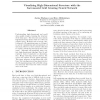Free Online Productivity Tools
i2Speak
i2Symbol
i2OCR
iTex2Img
iWeb2Print
iWeb2Shot
i2Type
iPdf2Split
iPdf2Merge
i2Bopomofo
i2Arabic
i2Style
i2Image
i2PDF
iLatex2Rtf
Sci2ools
ICML
1995
IEEE
1995
IEEE
Visualizing High-Dimensional Structure with the Incremental Grid Growing Neural Network
Understanding high-dimensional real world data usually requires learning the structure of the data space. The structure maycontain high-dimensional clusters that are related in complex ways. Methods such as merge clustering and self-organizing maps are designed to aid the visualization and interpretation of such data. However, these methods often fail to capture critical structural properties ofthe input. Although self-organizing maps capture high-dimensional topology, they do not represent cluster boundaries or discontinuities. Merge clustering extracts clusters, but it does not capture local or global topology. This paper proposes an algorithm that combines the topology-preserving characteristics of self-organizing maps with a exible, adaptive structure that learns the cluster boundaries in the data.
| Added | 17 Nov 2009 |
| Updated | 17 Nov 2009 |
| Type | Conference |
| Year | 1995 |
| Where | ICML |
| Authors | Justine Blackmore, Risto Miikkulainen |
Comments (0)

